翻译了一下荷兰Ham友PA3FWM写的关于MiniWhip天线的科普文章。
希望对各位了解这个天线有帮助。
文章来源:http://www.pa3fwm.nl/technotes/tn07.html
意译为主,较为随意,不足之处,在所难免。
只看重点的朋友请直接看结论部分和加粗部分。
Fundamentals of the MiniWhip antenna
Pieter-Tjerk de Boer, PA3FWM pa3fwm@amsat.org
(This is an adapted version of an article that I wrote for the Dutch amateur radio magazine Electron, January 2014.)
MiniWhip天线基本原理
作者:Pieter-Tjerk de Boer, PA3FWM pa3fwm@amsat.org
(这篇文章刊登在荷兰业余无线电杂志《电子》2014年1月刊,略有删减。)
翻译:BH7LSW建科
2017年11月
A well-known active antenna for the LF, MF and HF bands is the "MiniWhip" designed by PA0RDT; see [1]. Many ideas and misunderstandings have been voiced about how this antenna works. In this article, I hope to shed some light on this, by using some elementary theory.
PA0RDT大神设计的MiniWhip是一款众所周知的长中短波接收有源天线,关于它的工作方式,江湖上有许多误解。在这篇小文章里,我将用一些电磁学理论解释一下它的工作原理。
目录
1、MiniWhip概况
2、无线电波电场的规律
3、支撑杆为绝缘体的情况
4、无线电波的极化方式
5、振子用小金属板好还是用鞭状导线好
6、方向性
7、小尺寸天线的方向性
8、MiniWhip的方向性
9、结论
10、参考文献
关于本文作者及其WebSDR
1、The MiniWhip
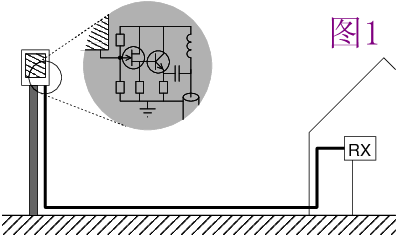
The figure shows a sketch of a typical MiniWhip setup. It consists of a mast of a few meters high, ideally in the open field, with on top of it a small metal plate and an amplifier, together in a plastic enclosure (the actual MiniWhip). A coaxial cable runs from the MiniWhip down along the mast to a receiver. For now we assume the mast is conductive and grounded, but we will later see what happens if this is not the case. The amplifier is a voltage follower with a very high input impedance in order not to load the metal plate, and a low output impedance to be able to deliver sufficient power to the 50 ohm coaxial cable; see [1,2,3]. The idea is that the metal plate "measures" the electrical field at its location, and sends the result via the coax to the receiver.
1、MiniWhip概况
上图是一个典型的MiniWhip天线架设图。它由以下部分组成:
一根数米高的支撑杆,放在开阔的地方,顶上固定着MiniWhip有源天线。
MiniWhip天线由一块小金属板(译注:小金属板即天线振子)和放大器构成,密封在塑料防水盒里,由同轴电缆引入室内的接收机。
现在,我们先假设这根支撑杆是金属的,且良好接地;后面我们再假设支撑杆为绝缘体的情况会怎样。
放大器是一个输入阻抗极高,而输出阻抗很低的射级跟随电压放大器,它将金属板获取的信号放大后通过50欧姆的同轴电缆传输到接收机。
小金属板的作用是测量空中电场的电势。
2、Principle and electric field
Let's make the following assumptions: the mast's height is small compared to the wavelength, and the signal to be received is vertically polarized. These are reasonable assumptions: the MiniWhip is often touted as an antenna for LF and MF (so with wavelengths of hundreds of meters), and those signals are predominantly vertically polarized (due to the influence of the relatively nearby conducting earth). At higher HF frequencies, these assumptions become less realistic, depending on the mast's height.
2、无线电波电场的规律
让我们做如下假设:支撑杆的长度比无线电波的波长要短很多,而且无线电波是垂直极化信号。这是合理的假设,因为长中短波的波长是比较长的,尤其是中波和长波,而支撑杆也就数米高;接近支撑杆的无线电波也往往是垂直极化的。但在短波高波段,这个假设就变得不太对头了,不过这也取决于支撑杆的长度。(译注:高波段波长在十米内,跟支撑杆的高度在同一个数量级了。)
Such a vertically polarized radio signal produces vertical fieldlines in the area around the antenna, and as a consquence the so-called equipotential surfaces (surfaces on which the potential, i.e. the voltage w.r.t. ground, is the same everywhere). The metal plate in the MiniWhip will be at the same potential as the equipotential surface crossing it.
垂直极化的无线电波在MiniWhip天线周边产生垂直电场,同时形成了等电势面,等电势面上的电势处处相等。MiniWhip天线的小金属板上的电势会等于它所在位置处电场的电势。
However, the amplifer in the MiniWhip is not just connected to the metal plate, but also to the grouned mast. To be more precise: the amplifier measurs the potential difference between the plate and the mast, buffers this, and applies this same potential difference between the shield and the center conductor of the coaxial cable. This is crucial: the signal that ends up in the receiver, is the potential difference between the plate and the mast.
放大电路不仅连接着小金属板,而且连接着金属支撑杆(译注:理论上,支撑杆是接地的,电路板上的“地”通过同轴电缆屏蔽层也是接地的)。更准确地说:MiniWhip放大电路的源信号是小金属板与支撑杆之间的电势差,放大后的信号通过同轴电缆的芯线和屏蔽层传输到接收机。换言之:接收机所接收到的信号就是经过放大的小金属板与金属支撑杆之间的电势差信号。
How large is this potential difference? The simplest reasoning says that the plate has the same potential as the field a few meters above the ground (the height of the mast), and the mast itself is at ground potential (because its lower end is grounded). However, this is a simplification. If the entire mast is at ground potential, the higher equipotential surfaces cannot cross it, and thus must be distorted.
这个电势差信号有什么不同呢?且看下图,由于支撑杆是金属且良好接地,所以在支撑杆杆尖处的电势等于“地”,也就是零。而支撑杆周边的电场线在经过支撑杆的时候不得不被扭曲压缩了。
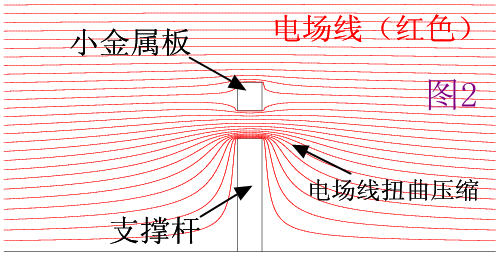
This figure shows what the distorted surfaces look like (calculated by having my computer solve the relevant Maxwell equation). The black line at the bottom denotes the earth. On it, there is a (rather thick, cylindrical) mast, and a metal block floats above it, both also shown in black. The metal block is the MiniWhip's metal plate. The red lines are the equipotential surfaces, or rather, cuts through them. Each of these lines corresponds to a potential, expressed in volts: the voltage of this equipotential surface w.r.t. ground. The earth and the mast itself are at ground potential, say 0 volts. The lowest red line could then e.g. be at 1 μV, the next at 2 μV, and so on.
上图是由麦克斯韦方程组推导而画出来。图中下面黑色那根是接地的金属支撑杆,上面那个黑色小方块是MiniWhip上的小金属板。红色的线表示等电势平面,不同的线相对于“地”分别有不同的电势。假如“地”是0V,那么最底下第一根红色线是1 μV,往上一根是2 μV,以此类推。(译注:也就是说,电场线不会被接地金属杆吸收掉,而是以扭曲压缩的方式存在,这由麦克斯韦方程组理论推导而得,是有理论依据的。)
Far away from the mast, the equipotential lines/surfaces are almost horizontal, as one would expect for a vertically polarized electric field. Around the mast, they are distorted, because the entire mast is at ground potential. And also around the metal block above it, the lines are distorted, because the potential on a conductor is the same everywhere. But actually, the distortion is not too bad; at the metal block the potential is hardly different than far away from the mast at the same height. Further calculations show that the distortion decreases as the mast becomes thinner.
在远离支撑杆的地方,无线电波的电场线是水平的,但在靠近支撑杆周围,电场线被严重扭曲压缩,变得接近垂直。它们之所以被扭曲,是因为金属支撑杆连着大地,整根杆的电势都等于“地”为零。而在离支撑杆比较远的地方,无线电波电势线就不怎么扭曲。由方程式推导可知,支撑杆越细,无线电波电场扭曲越少。
3、Isolated mast
What if the mast is not conductive? The amplifier will still measure the potential difference between the plate and the "ground" of the amplifier circuit. If the mast is not conductive, then the only thing connected to the circuit ground is the shield of the coaxial cable. In that case, the potential difference will be measured between the plate and whatever that cable shield goes to. If the cable shield is solidly connected to ground somewhere further on, it will work just as well as with a grounded mast. But if the shield is not grounded, goes into the shack and connects there to a "dirty" ground (e.g., the mains safety ground), well, then all noise on that dirty ground will contribute to the potential difference at the amplifier input, and thus end up in the receiver. Hence the importance of good grounding.
3、支撑杆为绝缘体的情况
当支撑杆为绝缘体时会怎样呢?这时由于支撑杆不是金属体,杆尖电势不再是零。MiniWhip的放大电路测量的是小金属板与“放大电路自己的地”之间的电势差。如果放大电路自己的地通过同轴电缆的屏蔽层可靠连接到了大地,那么,放大电路仍然测量的是小金属板与大地的电势差,与前述支撑杆为接地金属的情况一致。如果,同轴电缆的屏蔽层并没有可靠连接到真实大地,或者只是连接到“杂乱的地”(例如强电地线),那么这类地线上的噪音也会被MiniWhip的放大电路放大后送进接收机。可见,接地是极其重要的。
It might be an idea to replace the coaxial cable by a glass fiber. That would eliminate all noise coming into the amplifier via the coaxial cable. But without any conductive connection to the outside, the entire circuit will be at the same potential, so the received signal will not cause a potential difference that can be passed on to the receiver. As a consequence, nothing will be received. PA0RDT recently tried this in practice and reported about it on the RSGB-LF mailing list: indeed, he received nothing.
如果用光纤代替同轴电缆来传输MiniWhip放大后的信号,由于光纤杜绝了所有的电气噪音,会不会使得传送到接收机的信号十分理想呢?其实不然。因为没有了导体连接放大电路的“地”,小金属板上的电势与放大电路上所有地方的电势是一样的,没有了电势差,没有信号可放大,整个MiniWhip天线失去了意义。PA0RDT大神最近按照这个想法做过试验(译注:即用光纤传输信号),确实,什么信号也收不到。
4、Polarization
Another interesting experiment by PA0RDT was to not put the antenna on top of a vertical pole in the garden, but on a horizontal pole out of a window, with the coaxial cable also attached to that horizontal pole. He did this in such a way that the metal plate in either case ended up at the same spot, and noticed that the reception of a vertically polarized MF signal was equally strong. At first sight, this suggests that the antenna is not polarized: the reception is the same, even though the entire setup has been rotated from vertical to horizontal.
4、无线电波的极化方式
PA0RDT做了另一个有趣的研究,不把MiniWhip天线垂直安置,而是伸出窗外,水平放置,同样用同轴电缆引进室内的接收机。他发现接收效果跟垂直放置的时候一样。乍看起来,这个天线似乎并不在乎极化方式,它横竖怎么摆放都可以。
However, this conclusion is not correct. The amplifier still measures the potential difference between the plate and the pole (if conductive and grounded) or the coax shield (which presumably is grounded somewhere, possibly via the mains). So, the potential difference is still measured between the plate (which is again at the same spot) and the ground (which also has not changed), so it is to be expected that the resulting signal is the same. Whether the ground connection goes down vertically, or takes a partially horizontal detour, does not matter, as long as the detour is short compared to the wavelength.
但认为它不在乎极化方式却是错误的。不管支撑杆是否金属,放大器放大的源信号都是小金属板相对于“大地”的电势,只不过是相对于金属支撑杆这个直接的“地”,还是透过同轴电缆屏蔽层绕个大弯过来的“地”之间的区别而已,对于放大器来讲,两种情况效果是一样的;但这“绕个大弯的地线”,长度要比接受信号的波长短很多才好。(译注:亦即,如果同轴电缆过长,其长度与波长接近时,接收效果会变差。换言之,同轴电缆过长时,天线在低波段接收效果几乎不变,而高波段效果变差。)
5、Plate or whip
Most active electric field antennas do not, like the MiniWhip, use a metal plate, but a whip of about a meter long. This makes no essential difference for the operation. Such a whip will, if it is short compared to the wavelength, assume the average potential of its surroundings, in this case the potential about half a meter above the top of the mast. This half meter extra height will hardly affect the potential difference to ground.
5、振子用小金属板好还是用鞭状导线好
很多有源天线用的是一米长左右的鞭状导线做接收振子,而MiniWhip却是用一块小金属板,这是MiniWhip天线区别于其他天线的核心技术。假如我们用鞭状导线做振子,那么振子同样也是测量它所在空间位置的电场电势,只要振子长度没有长到跟波长差不多,对接收并没有多大改善。
However, there is another important difference, namely the capacitance of the plate or whip. A whip has a capacitance of almost 10 pF per meter of length, slightly dependent on it thickness. A circular metal plate has a capacitance of about 0.35 pF per cm diameter (proportional to the diameter, not to the area, as one might expect). I haven't found a formula for a rectangular plate, but the shape should not matter too much, so a typical MiniWhip has about 2 pF of plate capacitance. That capacitance is important, because together with the amplifier input capacitance it forms a capacitive voltage divider. If the plate or whip's capacitance is smaller, less voltage remains when the amplifier is connected.
接收振子的形状大小对另一项参数却有重要影响,即振子的分布电容。鞭状振子每米长度大概有10 pF电容,其粗细也会轻微影响电容大小。小金属板每厘米直径大概有0.35 pF电容,其电容大小与直径成比例,而不是面积。我还找不到一个合适的方程式来拟合矩形小金属板的电容大小,但可以估计出一个典型的MiniWhip小金属板的电容大约为2 pF。振子电容的大小十分重要,因为放大器输入端与振子形成电容分压,如果振子电容太小,会使得输入放大器的信号电压也变小(译注:放大器输入端电容应该是指晶体管输入端结电容)。
6、Directivity
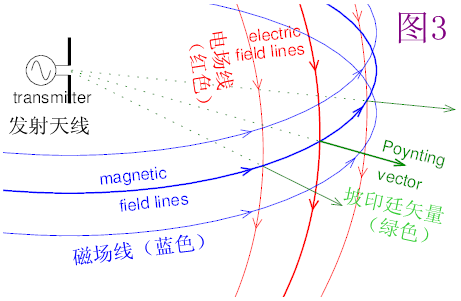
Before we can say anything about the directivity of an antenna, it's good to have a closer look at what is or determines the "direction" of a radio signal. The figure shows a vertically polarized transmitting antenna, and the electric and magnetic field lines produced by this antenna at a large distance (the so-called far field). We see that the electric fieldlines are vertical, not surprisingly since the electric field is caused by e.g. the top half of the dipole being charged positively and the bottom half negatively (or the other way around, half a period later). We also see that the magnetic field lines are horizontal, forming a large circle around the antenna; this is also to be expected, since we know that magnetic field lines form circles around a current-carrying wire.
6、方向性
在讨论天线的方向性之前,先科普一下典型天线的电磁场是什么样的。如上图,一个垂直极化的天线发射的无线电波(译注:图上是个竖直放置的标准DP天线),在距离天线很远的地方(即远场),电场线是垂直方向(红色线),磁场线为水平方向环绕天线(蓝色线)。
The figure also shows the so-called Poynting vector. It is named after the English physicist J.H. Poynting, and points in the direction in which the wave propagates. Mathematically it is given by the so-called outer product of the electric and magnetic field vectors. Its direction can be determined by turning one's lefthand such that it catches the magnetic field lines into its palm, and the fingers are aligned with the electric fieldlines; then the thumb indicates the direction of the Poynting vector.
How can an antenna be more sensitive to signals from one direction than from another? If the antenna could directly sense the Poynting vector, it would be easy, since this vector indicates directly the propagation direction. Unfortunately however, antennas do not respond to the Poynting vector but only to the electric and/or magnetic field.
上图也画出了坡印廷矢量(绿色线),坡印廷矢量指明了电波的传播方向,它可以由左手定则判定。
如何使得一个接收天线在某个方向比其他方向更灵敏?理论上讲,假如天线刚好与坡印廷矢量一致,那么天线就能达到最佳灵敏度。但不幸的是,天线实际上对坡印廷矢量并不感冒,而是对电场线及磁场线有反应。
The first way in which an antenna can have directional sensitivity, is by measuring the electric or magnatic field at several places and "comparing" the phase of the signal at those places. This happens e.g. in a Yagi antenna: a signal that arrives from straight ahead, reaches the first director earlier than the dipole. However, for small antennas this principle doesn't work: if the antenna is small compared to the wavelength, the signal arrives almost simultaneously everywhere in the antenna, and thus does not give a significant phase difference.
一个天线要对方向敏感,最好的方法是在不同的位置感应到无线电波,比较出电波相位的不同,例如八木天线就是这样工作的:电波先抵达引向振子,然后才到达馈电振子。(译注:八木天线一般还有反射振子,引向振子和反射振子分别感应电波的不同相位,使得馈电振子接收的信号翻倍。)但是,对于小尺寸的天线却不一定了。当天线的尺寸比电波的波长小很多时,一个波长内的电波几乎同时到达天线的任何部位,天线并不能感应出电波相位的差别。
7、Directivity of small antennas
For a small antenna to be directionally sensitive, the only possibility is to use the direction of the electric and magnetic field lines themselves. Unfortunately, they do not always reveal the direction from which the signal is coming.
7、小尺寸天线的方向性
对于小尺寸天线而言,想要考量其方向性,唯一的可能就是跟着电场线或磁场线的方向走。但再次非常不幸,电磁场线传播到天线的时候,其方向已经乱套了。(译注:长中短波信号要么地波长距离衍射,要么电离层多次反射,其极化方向会变得不可预测。)
Consider the vertically polarized field in the previous figure. The electrical field lines at the place of the receiver are vertical, regardless of whether the transmitter is left or right, front or rear. Thus we cannot conclude from the electric field from which direction the signal is coming. (Well, we can conclude that the signal is coming in horizontally rather than steeply from up in the sky. But usually that's not so interesting.)
对于上图中垂直方向的电场,我们的接收机不能从接收到的电场的方向判断出发射信号来自哪个方向,因为不管发射信号在东南西北哪个方向,到达接收天线的电场信号都是垂直方向的。(但至少我们可以知道信号肯定来自水平方向,而不是来自头顶方向,不过这没多大意义。)
In contrast, the magnetic field lines do say something about the direction. If e.g. the transmitter is west of us, then the magnetic field lines are in a north-south direction. If the transmitter is north of us, the magnetic field lines run east/west. But this is not unambiguous: if the transmitter would be south of us, the magnetic field lines would also be east/west. In other words: in case of a vertically polarized signal, the magnetic field lines tell us from which direction the signal is coming, albeit with a 180 degree uncertainty. And this is of course well known from portable mediumwave radios with a built-in ferrite rod antenna: such an antenna is directionally sensitive, but if one rotates it by 180 degrees, reception doesn't change.
相反地,磁场方向就有用的多了。假如发射信号在我们的西边,那么磁场线就是南北走向的。再假如发射信号在我们的北边,那么磁场线就是东西走向的,而当发射信号在我们的南边,磁场线也是东西走向的,只是方向相差了180度。也就是说,对于垂直极化的磁场信号,我们可以通过接收到的信号来判断它来自哪个方向,尽管有180度的不确定性。就如收音机里的中波磁棒天线一样,它是有方向敏感性的,但转动180度后,接收效果是一样的。
Fox hunters / ARDF participants on 80 meters also use ferrite antennas that respond to the direction of the magnetic field lines. To resolve the 180 degree ambiguity, these receivers often have an additional "sense antenna": a whip that responds to the electric field. As noted before, that field says nothing about the direction of the signal, but it can resolve the 180-degree ambiguity of the magnetic fieldlines: depending on the direction, the electric signal is in phase or 180 degrees out of phase with the magnetic signal.
A nice application of these principles is DF6NM's directional longwave receiver [4]. He uses two magnetic antennas under 90 degree angles to determine the direction of the signal, and an electric antenna to resolve the 180-degree ambiguity. He uses this data to produce a waterfall diagram in which the color indicates the direction.
80米波段的测向机也用了一根磁棒来确定测向信号的磁场方向,为了解决存在的180度不确定性,测向接收机通常加了根鞭状天线来感应电场方向。如前所述,电场线并不能告诉我们信号的方向,但它能在依靠磁棒天线确定大体方向之后帮助我们解决那180度不确定方向的问题:判断电场方向与磁场线是否同相位即可。DF6NM设计的一种测向机有两根互相垂直的磁棒,外加一根测电场的鞭状天线,可以直接在图形上指示出信号方向。
All considerations so far were about vertically polarized signals. For horizontally polarized signals the situation is reversed: the electric field lines run horizontal and reveal the direction, while the magnetic field is vertical and says nothing about the direction.
以上所有的结论均假设无线电波是垂直极化信号,当无线电波是水平极化时,所有的结论均相反:磁场线是垂直的,不能用于判断信号方向;电场线是水平的,可以判断信号方向,但有180度不确定性。
8、Directivity of the MiniWhip
And what about the MiniWhip? We have already seen that it responds to the electric component of a vertically polarized signal, and that it is small compared to the wavelength. Then only one conclusion is possible: it is not directionally sensitive.
8、MiniWhip的方向性
上面谈论了小尺寸天线的方向性,那么对于MiniWhip天线而言,结论会怎么样呢?我们已经知道MiniWhip天线只接收垂直极化的电场信号,而且它的尺寸比波长小很多,唯一的结论就是:它也是没有方向敏感性。
However, the MiniWhip does have a dip straight up: it will not respond to signals coming from straight above. Such signals have both their electric and magnetic field lines horizontal, and then there is nothing left for this antenna to respond to. This is quite noticeable with my WebSDR at the University of Twente. Occasionally Dutch users complain that its antenna is bad because they cannot hear Dutch stations on 80 m too well; but those signals bounce off the ionosphere almost vertically.
然而,MiniWhip对来自头顶方向的信号却毫无反应。因为这个方向的无线电波的电场线和磁场线都是水平方向的(译注:参看图3,相当于坡印廷矢量向下),并不能在天线位置产生出电势差。从我设置在荷兰特温特大学的WebSDR接收机可以看出,经常有荷兰的Ham友抱怨这个WebSDR接收荷兰境内的80米波段信号很差劲,其实原因就在于这个距离左右的80米波段信号经过反射到达WebSDR天线的时候几乎是垂直方向了。
Some people have suggested that in order to receive signals coming from straight above, one should mount a horizontal plate on top of the MiniWhip's vertical plate. This is not going to work: the MiniWhip would still measure the potential difference between the plate and the ground, and for signals from straight up that difference is 0.
许多朋友建议,为了接收头顶方向的信号,在小金属板一端再接个水平方向的金属板(译注:即做成L形状的金属板)。但这并没卵用,MiniWhip仍然只是测量它所在位置与大地之间的电势差。而对于来自头顶方向的电波信号,能产生的电势差为零。
9、Conclusions
What can we conclude from all of this theory?
- The MiniWhip is vertically polarized.
- Grounding is important: if the antenna is only grounded in the shack, via the coax cable, much noise can be picked up. B.t.w., that grounding does not need to be galvanic: a large piece of metal, even if not connected directly to the earth, may have enough capacity to serve as ground.
- The strength of the received signal is directly proportional to the height of the antenna above ground, as long as this is small w.r.t. the wavelength.
- Whether the mast is conductive or not hardly matters for the reception. However, if the mast is conductive, the antenna's plate must of course not be mounted besides but above the mast.
- The antenna is omni-directional, except for a dip straight up.
- The orientation or shape of the metal plate do not matter; b.t.w., this is also true for the whip in case of whip-based active antennas.
9、结论
1、MiniWhip是垂直极化的。
2、接地非常重要。如果天线只是通过同轴电缆接到了电台的地,会引入噪音。但“地”并非一定要能流通的地线,不与大地连接的虚拟地也是可以的,只要金属部分足够大,以满足放大器输入端输入电容的需求。
3、接收到的信号强度与天线离地面的高度成正比,但高度要比波长小。
4、支撑杆是否金属无关紧要。但如果支撑杆是金属的,那么MiniWhip天线要放置在支撑杆顶上方适当位置,而不能放置在杆身旁边。
5、MiniWhip天线接收是全向的,除了头顶方向之外。
6、小金属板的形状和摆放方向是无关紧要的,即使用鞭状振子也如此。
10、References
10、参考文献
[1] De pa0rdt-Mini-Whip, een actieve ontvangantenne voor 10 kHz tot 20 MHz, PA0RDT, Electron 5/2006.
[2] http://pi4utr.nl/wp-content/uploads/download/pa0rdt_whip.pdf
[3] Technische notities van PA3FWM, Electron 3/2010.
[4] http://df6nm.de/ColourDF/ColourDF.htm
[5] AN-32 FET Circuit Applications, Texas Instruments.
[6] Active Reception Antennas, Observations, Calculations and Experiments; Detlef Burchard, VHF Communications 2/96 (and UKW-Berichte 4/94).
Text and pictures on this page are copyright 2013, P.T. de Boer, pa3fwm@amsat.org .
Republication is only allowed with my explicit permission
关于本文作者及其WebSDR
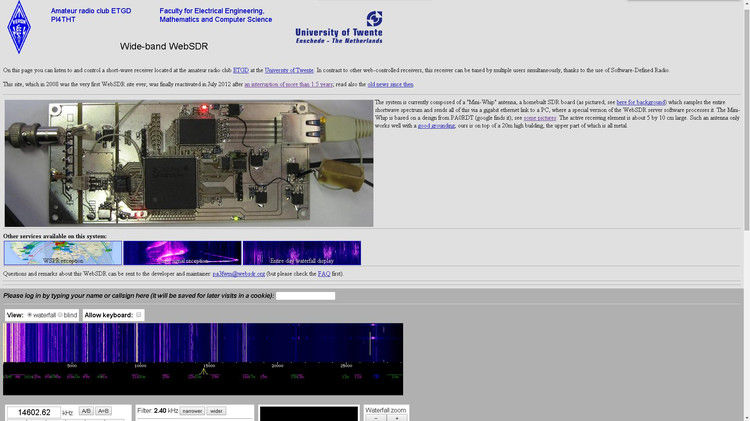
如上图,这个WebSDR网页想必很多Ham友非常熟悉了,
网址是:http://websdr.ewi.utwente.nl:8901/
这个SDR接收机(如下图)为本文作者PA3FWM纯手工打造,
而其所采用的天线,正是MiniWhip有源天线。
直接打开上面的网页即可体验到MiniWhip天线的魅力。
其天线的详细介绍请见:http://websdr.ewi.utwente.nl:8901/qrt.html
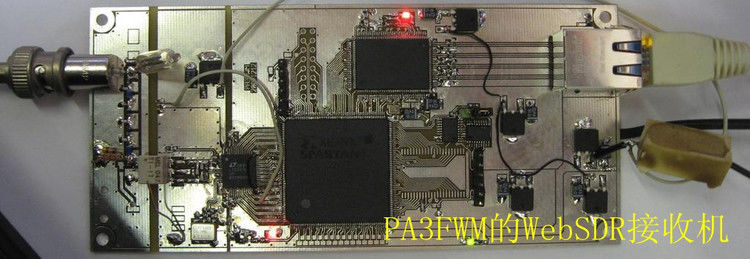
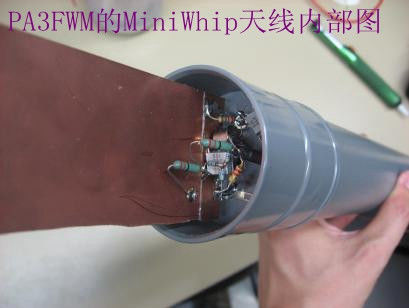
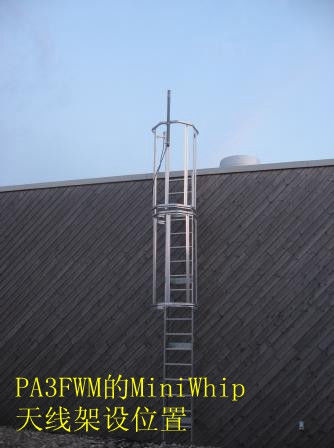
天线架设在荷兰特温特大学校园内的某个屋顶上。
特温特大学University Of Twente是荷兰顶尖理工科大学之一。
这是本文作者PA3FWM的个人主页:http://wwwhome.cs.utwente.nl/~ptdeboer/
可见PA3FWM帅哥著述颇丰。

